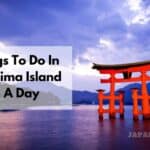Celebrate Oedo Fukagawa Sakura Festival in Edo Period-Style Hanami Along The Oyokogawa River. Read on to find out how!
Immerse yourself in history! Travel back to the Edo era for a unique hanami experience at the Oedo Fukagawa Sakura Festival. Don traditional garb, savor local delicacies, and witness captivating performances under a canopy of delicate cherry blossoms.
Page Contents
Sakura Blossoms on the Oyokogawa
As Tokyo welcomes the start of spring, I find the Oedo Fukagawa Sakura Festival a truly captivating experience. In the heart of the city, along the Oyokogawa River, the festival showcases approximately 270 Somei Yoshino cherry trees.
These trees, known for their low-hanging branches that sweep towards the water, line the river for 1.3 kilometers, offering a spectacle of natural beauty.

What Makes Oedo Fukagawa Sakura Festival Unique?
- Historic River Boat Rides: Glide down the river on a traditional boat, steered by a boatman with a single oar, to fully immerse in a bygone era. You can also opt for a modern motor-powered vessel.

- Evening Illuminations: From 5 p.m. to 10 p.m., the cherry blossoms are illuminated, transforming the nightscape into a breathtaking floral display.
- Local Entertainment: Enjoy performances by the Fukagawa Canoe Club and tunes from a local jazz ensemble as part of the festival’s diverse offerings.
- Culinary Delights: Sample regional delicacies like Fukagawa rice and flame-grilled scallion skewers at the Hanami Cafe, a temporary market perfect for gastronomy enthusiasts.
- Cultural Exhibitions: Stroll along the river to see an array of photographs displaying the historic and current charm of the riverside, accompanied by explanations regarding the river’s flood control evolution.
| Event Timings | March 18 – April 2 |
| Boat Ride Hours | 10 a.m. – 3 p.m. (Weekends & Holidays) |
| Lighting Hours | 5 p.m. – 10 p.m. |
| Admission | Free |
| Special Features | Historical Display & Photographic Exhibition |

Visiting early in the festival is prudent as cherry blossoms are famously ephemeral, and with predictions pointing to an earlier bloom this year, time is of the essence to catch them in full splendor.
Engaging in this event promises a timeless hanami experience, truly befitting Tokyo’s rich tradition.
- Related: Cherry Blossom Taxi Tours In Tokyo
Preparing For your Edo Period Hanami
Immerse yourself in the magic of Edo period Hanami by dressing and packing in accordance with the customs of the era. Here’s what you’ll need to get ready for a truly unforgettable experience:
- Dressing Up for the Occasion
- The Kimono: The heart of your Edo period attire.
- Women: Opt for a brightly colored Kosode (kimono with shorter sleeves) decorated with floral patterns or nature scenes. Unmarried women traditionally wore Furisode (long, flowing sleeves).
- Men: Choose a Kimono in muted tones like black, grey, or indigo. Samurai might wear a Haori (short jacket) over their Kimono.
- Accessorize with Elegance:
- Obi (Sash): A wide sash to cinch your Kimono. Choose a vibrant Obi for a touch of personality.
- Tabi Socks: Split-toed socks worn with traditional sandals (Zori or Geta).
- Hairstyles: Women: Updo hairstyles adorned with Kanzashi (hairpins). Men: Topknots or shaved heads.
Renting vs. Owning:
Kimono rentals are readily available near the festival or online. This is a fantastic option for a first-time experience. If you plan to attend future festivals, consider purchasing a pre-owned Kimono or having one custom-made.
- Packing for a Delightful Hanami
Embrace Tradition with your Picnic Basket:
- Ditch the bulky bags and opt for a Bamboo Basket (弁当箱, Bentobako) for a truly Edo period feel.
- For a touch of elegance, consider wrapping your food and belongings in a Furoshiki Cloth (風呂敷). These beautiful cloths come in various sizes and patterns.
Edo Period Culinary Delights:
Pack a delicious Bento box filled with Edo period staples like:
- Onigiri (Rice Balls): Simple and portable, perfect for a picnic.
- Yakitori (Grilled Skewers): Chicken, vegetables, or seafood skewers grilled to perfection.
- Tempura (Fried Vegetables): Light and crispy tempura vegetables are a crowd-pleaser.
- Tsukemono (Pickled Vegetables): A refreshing and tangy side dish.
Drinks:
Enhance your picnic with traditional beverages:
- Sake (Rice Wine): Sip on a small amount of sake for a taste of history. (Remember to check local regulations on alcohol consumption at festivals.)
- Green Tea (Ocha): A refreshing hot or cold beverage to cleanse the palate.
Experiencing the Edo Fukagawa Sakura Festival
A. Arrival at the Festival
- Getting There: Take the train to Monzen-nakacho Station on the Tozai Line. The festival is a short walk from the station.
- Navigating the Festivities: Upon arrival, follow the signs and the beautiful blooms towards the Oyokogawa River. You’ll be greeted by a vibrant atmosphere filled with locals and visitors alike, all enjoying the cherry blossoms.

B. Traditional Hanami Activities
- Setting Up Your Picnic: Find a picturesque spot under the sprawling branches of the cherry trees. Unfurl your Furoshiki cloth or spread your blanket to create your Edo period-inspired picnic space. Arrange your Bento box, drinks, and any other treats you brought.
- Embrace the Entertainment: Keep an eye out for traditional performances that might be happening throughout the festival. You might hear the melancholic tunes of the Shamisen (Japanese lute) or witness a dance performance reminiscent of the Edo period.
- Nighttime Illuminations: As twilight approaches, the magic truly unfolds. The cherry blossoms along the Oyokogawa River are illuminated, creating a breathtaking scene straight out of an Edo period painting. Take a stroll along the riverbank and marvel at the beauty of the illuminated blossoms.
C. Optional Activities (if time permits)
- A Boat Ride Through Time: Take a traditional Japanese wooden boat ride on the Oyokogawa River. Imagine yourself as an Edo period merchant or a pleasure seeker cruising under the cherry blossoms. (Tickets and availability might be limited, so plan accordingly.)
- Exploring Edo Period History: If you have time to spare, delve deeper into Tokyo’s Edo period history. Visit nearby museums like the Fukagawa Edo Museum or explore the preserved streets of the Ningyocho district.
Oedo Fukagawa Sakura Festival: FAQs/
What Are The Traditional Festivities at Oedo Fukagawa Sakura Festival?
I participate in various time-honored activities offered at the festival. This includes riding in traditional boats, watching live performances, and strolling alongside the cherry blossom trees adorned with lanterns.
- Boat Rides: I enjoy boat rides along the canals to view the blossoming cherry trees from a different perspective.
- Performances: Local artists perform traditional music and dance, showcasing cultural heritage.
- Walks Under the Blossoms: I take leisurely walks beneath illuminated cherry trees for an immersive experience.
What Is The Recommended Attire for Festival-Goers?
When I attend the festival, I opt for comfortable clothing suitable for outdoor activities. Many participants embrace traditional Japanese attire.
- Casual Comfort: Outdoor wear appropriate for the weather is essential as I spend a lot of time outside.
- Yukata/Kimono: Some may choose to wear a yukata or kimono to appreciate the festive ambiance and Japanese tradition.
Edo Period’s Influence on the Festival’s Traditions
I recognize that the Edo period’s customs significantly influence the festival’s activities, encapsulating the historic period’s essence.
- Historic Themes: The event replicates the Edo period’s hanami practices to give me a taste of history.
- Authentic Decor: With Edo-style lanterns and decorations, I feel transported back in time.
What Is The Cultural Significance of Edo Period Hanami?
The practice of hanami during the Edo period, which I appreciate, carries a profound cultural meaning as a celebration of life’s transience.
- Cherry Blossoms (Sakura): The fleeting beauty of cherry blossoms reminds me of the impermanence of life, a significant reflection in Japanese culture.
- Social Gatherings: Sharing hanami with others during the Edo period symbolized the coming together of community and enjoyment of nature.
What Are The Prime Cherry Blossom Viewing Locations at the Festival?
For the best cherry blossom sights, I seek out specific areas within the festival grounds that offer spectacular views.
- Fukagawa-machi Park: Here, I find a stunning array of cherry trees lining the park’s pathways.
- River Canals: Aboard a traditional boat, I gain a unique perspective of overhanging cherry blossoms.
What Are Culinary Delights Enjoyed at the Festival?
I indulge in a variety of delectable foods that are a staple of the festival and Japanese culinary tradition.
- Street Food Stalls: I visit the many stalls serving takoyaki, yakitori, and sweet treats such as dango.
- Seasonal Offerings: Sakura-flavored delicacies like sakura mochi are my favorites to celebrate the season.
My writing focuses on the various aspects of Japanese lifestyle, from traditional tea ceremonies and flower arrangement to modern fashion trends and pop culture. Through my articles, I aim to share my passion for Japan and provide readers with a glimpse into the rich and diverse world of Japanese culture.
I believe that the key to understanding Japanese lifestyle is to appreciate the balance between tradition and innovation. While Japan has a rich cultural heritage that dates back centuries, it is also a country that is constantly evolving and embracing new ideas and technologies.
Whether you’re interested in learning about the latest fashion trends in Tokyo, or want to explore the ancient art of calligraphy, my writing will take you on a journey through the many facets of Japanese lifestyle. So join me as we explore the beauty and complexity of this fascinating culture together!





